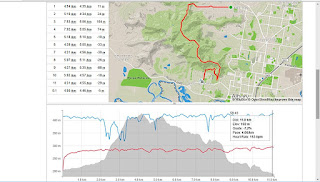I'm into my second week of
'de Verheul methode' of training and still
excited about the prospect of faster race times. I thought I'd briefly
summarise my early thoughts on the possible advantages of training this
way. I've always been an admirer of Arthur Lydiard and his training
methods, as well as the Lydiard influenced 'complex training' of Pat
Clohessy (Rob de Castella's coach) and Chris Wardlaw (Steve Moneghetti).
Personally I've experienced success following the ideas of Hadd,
Maffetone and more recently the LSD teachings of Joe Henderson
(
"Long Slow Distance: The humane way to train"). Most
of my lifetime PBs were set when I was being coached by
Geoff Moore. The
Verheul Method is the first time I've run using 'interval training' on 5
days of the week. The advantages as I see it are as follows:
1) Changes to the leg muscles and tendons. This is the key advantage.
Klaas Lok (Verheul's champion athlete) suggested there should be a
'muscle elasticity meter' that told the runner to stop a continuous
distance run the moment reactivity (spring off the ground) decreased.
Running a large volume of 'relaxed' intervals promises to change the
muscles, thereby improving muscle reactivity and running form.
2) It's not a hard day/easy day style of training. Every day is a
repeatable 'Goldilocks' day — not too easy, not too hard, just
right. I presume this is because maximum heart rates are low and the
running is well below anaerobic threshold (no lactic acid). Intervals
are totally aerobic, short and relaxed. There's no waiting two days
before the next hard session. Verheul agreed with Hungarian coach Mihaly Iglói who believed in not training harder than one's ability to be recovered for similar training the next day.
3) The only 'hard' running is the weekly race. This is the one time
speed is continuous and the heart rate is high. Racing is a good
environment in which to run fast because warm-ups are thorough, you're
running with like-minded friends and intent is serious. Besides, racing
is fun!
4) Mileage is relatively low. Having manageable targets for weekly
mileage lessens the likelihood of over-training and sickness. You're not
pushing your body near the tipping point of what's possible with volume.
Verheul didn't prescribe schedules but I estimate that Klaas Lok and
Joost Borm ran around 100 kilometres (60 miles) per week, possibly less.
I'll target a weekly volume of between 60 and 70 kilometres (60 is the
point below which I think I'd lose aerobic fitness). Such low volume is
not 'Lydiard' and wouldn't suit marathon racers but Verheul's protégés
Lok and Borm were Dutch champions. I'll list their track PBs in the last
paragraph of this post.
4) The training is fun and not daunting. Thus far I've been looking
forward to every session with legs feeling recovered and ready to go
each day (often not the case when I've been logging higher mileage).
Moderately intense and fun training has hormonal advantages over high
stress training. I enjoy the feeling of running fast! The 3k to 5k race
pace of most intervals is a lot faster than recovery or LSD running. I
have the opportunity to do a few sessions each week within organised
'handicap start' runs and my usual 7 minutes per km average pace is
quick enough to keep up with slower runners. Verheul used gymnastics as
part of the warm-up for daily training, which would be fun in a group
setting. I'll be using running drills instead of gymnastics.
5) Improved running economy at 5k race pace. If I add up all the fast
intervals, fast sections of a fartlek trail run (and the weekly race),
I'll be running about 30 kilometres per week at race pace. I think this
will be beneficial at a neuromuscular level. Already I can feel that my
cadence is faster and time on stance is shorter. I feel lighter on my
feet. The other 30 kilometres of my training week is made up of the
walk/jog recoveries, shake-out treadmill jogs and easy warm-ups and
warm-downs.
Bob wondered in a comment on my previous blog if there would be enough
mileage in a Verheul programme to race half marathons. The Saturday
winter fartlek run was from 1 hour 15 to 1 hour 45 minutes duration so I
think extending this a little in the build-up to a half marathon would
be sufficient to race well. It seems that Joost Borm was a 'miler' and
had PBs of 3:38.27 for 1500m, 4:01.5 for the mile and 5:01.27 for 2000m
(which stood as the Dutch record from 1982 to 2001). Klaas Lok's PBs
were 2:21.8 for 1000m, 3:38.83 for 1500m, 5:03.9 for 2000m, 7:52.5 for
3000m, 13:36.1 for 5000m, 28:24.7 for 10,000m and 3:57.69 for the mile
— all recorded between 1976 and 1981. I've no doubt that Lok
would have run a good half marathon if that distance had been popular
when he was racing.
Spectacular views at the Gungahlin Gallop 10k on Sunday




















